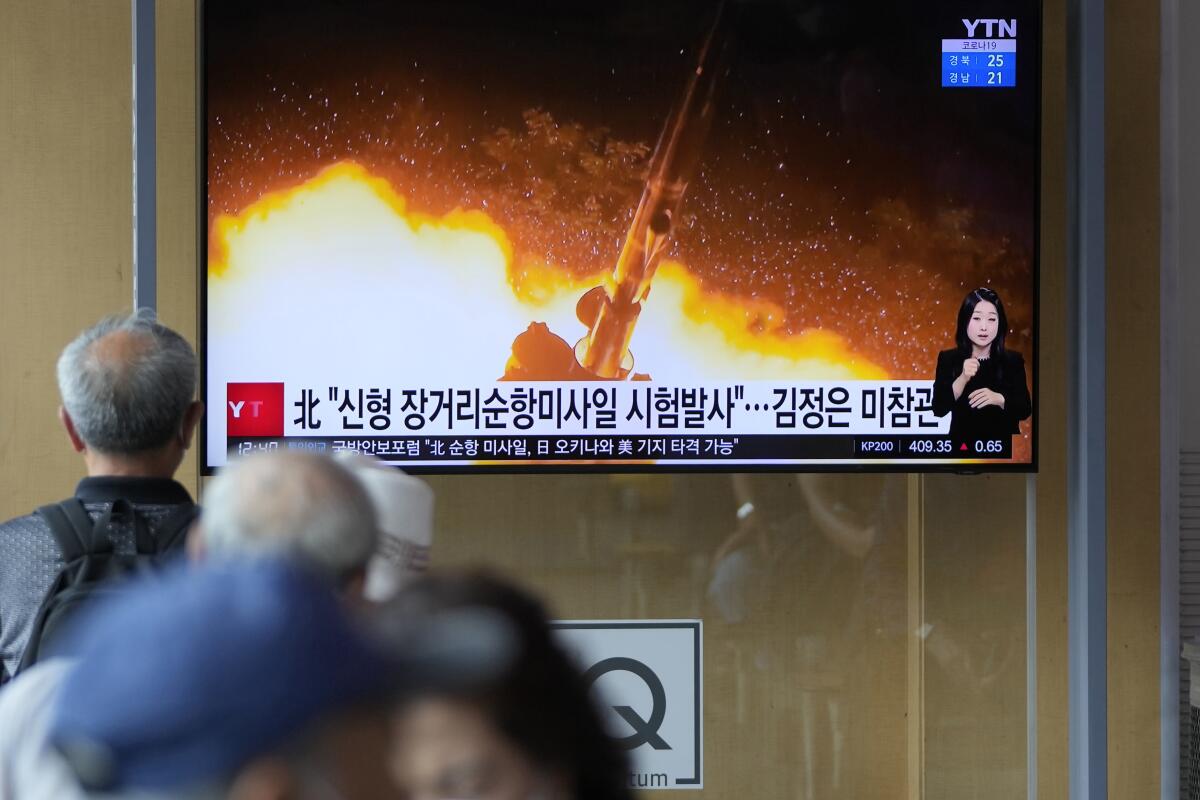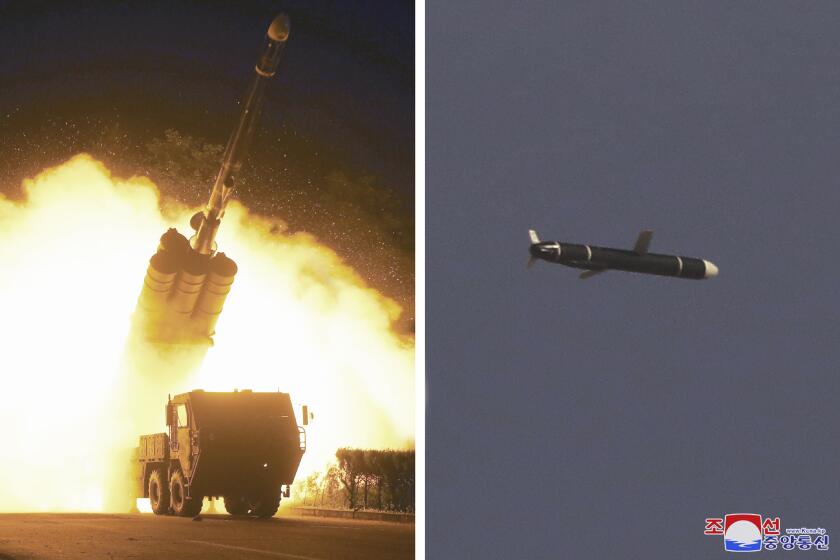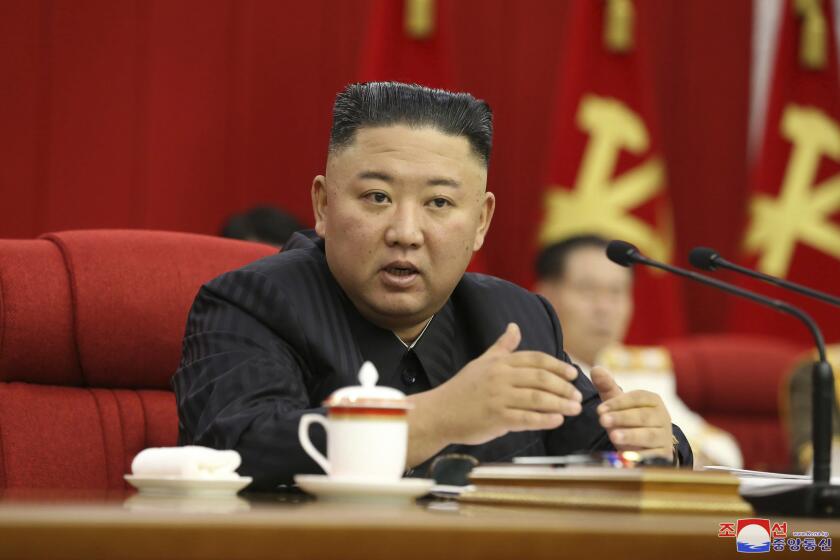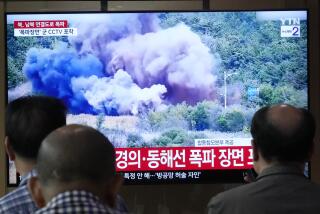Explainer: How much of a threat do North Korea’s new missile tests represent?

SEOUL — North Korea says it successfully tested what it described as new long-range cruise missiles over the weekend, renewing concerns that Pyongyang is building its capacity to deliver strikes on U.S. allies South Korea and Japan.
Experts weigh in on what the missiles tests show about the ambitions of the North’s isolated ruler, Kim Jong Un, and whether this signals a new threat.
The missiles’ design
Experts say the projectiles launched over the weekend appear to resemble U.S. Tomahawk cruise missiles, and are likely designed to overwhelm the missile defenses of North Korea’s neighbors.
The North said the missiles it described as “new type long-range cruise missiles” were a “strategic weapon of great significance” that met leader Kim’s call to strengthen his country’s military might — implying that they were being developed with an intent to carry nuclear weapons.
North Korea says it successfully test-fired what it described as new long-range cruise missiles capable of hitting targets nearly 1,000 miles away.
Pyongyang’s official Korean Central News Agency said Monday that the missiles traveled for 126 minutes along “oval and pattern-8 flight orbits” above land and water, demonstrating an ability to hit targets 932 miles away.
Although North Korea had tested anti-ship cruise missiles before, the ones from its latest tests are probably built with different designs and engines that provide improved range and maneuverability, experts say.
A new threat
Although data from the tests are so far limited, it’s clear the new missiles represent “another significant milestone for North Korea’s nuclear program,” said Melissa Hanham, an affiliate at Stanford’s Center for International Security and Cooperation.
North Korea’s rulers are probably moving toward putting their cruise missiles on submarines and other naval vessels, Hanham added, as they try producing new delivery mechanisms for nuclear weapons.
Kim Jong Un has ordered his government to be fully prepared for confrontation with the United States over North Korea’s nuclear arsenal.
“Cruise missiles are almost like little airplanes — they can be very accurate,” Hanham said. “They can turn corners. They can go into valleys where radars would not see them easily. It would be a much more difficult problem for South Korea and Japan to monitor.”
Seoul, Washington and Tokyo said they were examining the North’s latest tests but didn’t immediately release specific assessments from their militaries.
Regional ambitions
Kim has unilaterally halted North Korean testing of nuclear bombs and long-range ballistic missiles designed to target the American homeland since 2018 when he initiated diplomacy with then-President Trump while attempting to leverage his arsenal for sanctions relief.
However, the North continues to pursue a policy threatening regional confrontation.
News Alerts
Get breaking news, investigations, analysis and more signature journalism from the Los Angeles Times in your inbox.
You may occasionally receive promotional content from the Los Angeles Times.
Although Kim has maintained the suspension on nuclear and long-range tests even after his talks with Trump collapsed in 2019, the North has since tested a growing arsenal of short-range solid-fuel weapons fired from land-based launchers.
Experts say those weapons threaten South Korea and Japan because they can be launched quickly from vehicles and travel in flattened trajectories that make them harder for defense systems to detect and intercept.
Tech problems
Although the new cruise missiles potentially expand North Korea’s capacities to attack its Asian rivals, the information released by the official news agency signaled a need for technological improvements, said Lee Choon Geun, a missile expert and honorary research fellow at South Korea’s Science and Technology Policy Institute.
The weapons were slow, even by the standard of cruise missiles, traveling at roughly 218 yards per second. It’s also unclear whether North Korea has precise computerized data of South Korea’s geographical features or an ability to communicate that information to its missiles so that they could navigate the terrain and find their targets.
U.N. human rights investigators have asked North Korea to clarify whether it has ordered troops to shoot on sight any trespassers who cross its northern border in violation of the country’s pandemic closure.
Accuracy issues will matter less if the North acquires the ability to arm the missiles with miniaturized nuclear warheads, Lee added.
“South Korea probably has the tightest air defense network in the world, but it will still be difficult to respond if North Korea fires its artillery, low-flying short-range missiles, submarine-launched missiles and cruise missiles in large numbers all at once,” Lee said.
Kim’s bluff?
The North’s latest tests came before President Biden’s special representative for North Korea, Sung Kim, was to meet his South Korean and Japanese counterparts in Tokyo this week to discuss the stalled nuclear diplomacy with North Korea.
In recent political speeches, Kim has vowed to bolster his nuclear deterrent while his government rejected the Biden administration’s overture for talks, urging Washington to abandon its “hostile” policies first.
Kim, however, may be looking to angle his way back to the negotiating table, as he faces perhaps his toughest test in his almost decadelong rule, with North Korea maintaining an indefinite border lockdown amid the COVID-19 pandemic, and no prospect in sight of an end to international sanctions.
North Korean leader Kim Jong Un berates top officials for coronavirus-prevention failures that have caused an unspecified ‘great crisis.’
Although the cruise missiles were a statement of defiance toward Washington, the tests possibly indicated that the North is struggling with more provocative weapons systems such as submarine-launched ballistic missiles, said Du-Hyeogn Cha, an analyst at Seoul’s Asan Institute for Policy Studies.
He questioned whether North Korea’s cruise missiles would meaningfully increase its striking capacity unless the North demonstrates an ability to fire them from underwater.
“If North Korea had that ability, it surely would have displayed it by now,” Cha said.
“It’s possible that the North might have hit a wall technologically and is squeezing out what it can,” he added.
More to Read
Sign up for Essential California
The most important California stories and recommendations in your inbox every morning.
You may occasionally receive promotional content from the Los Angeles Times.














